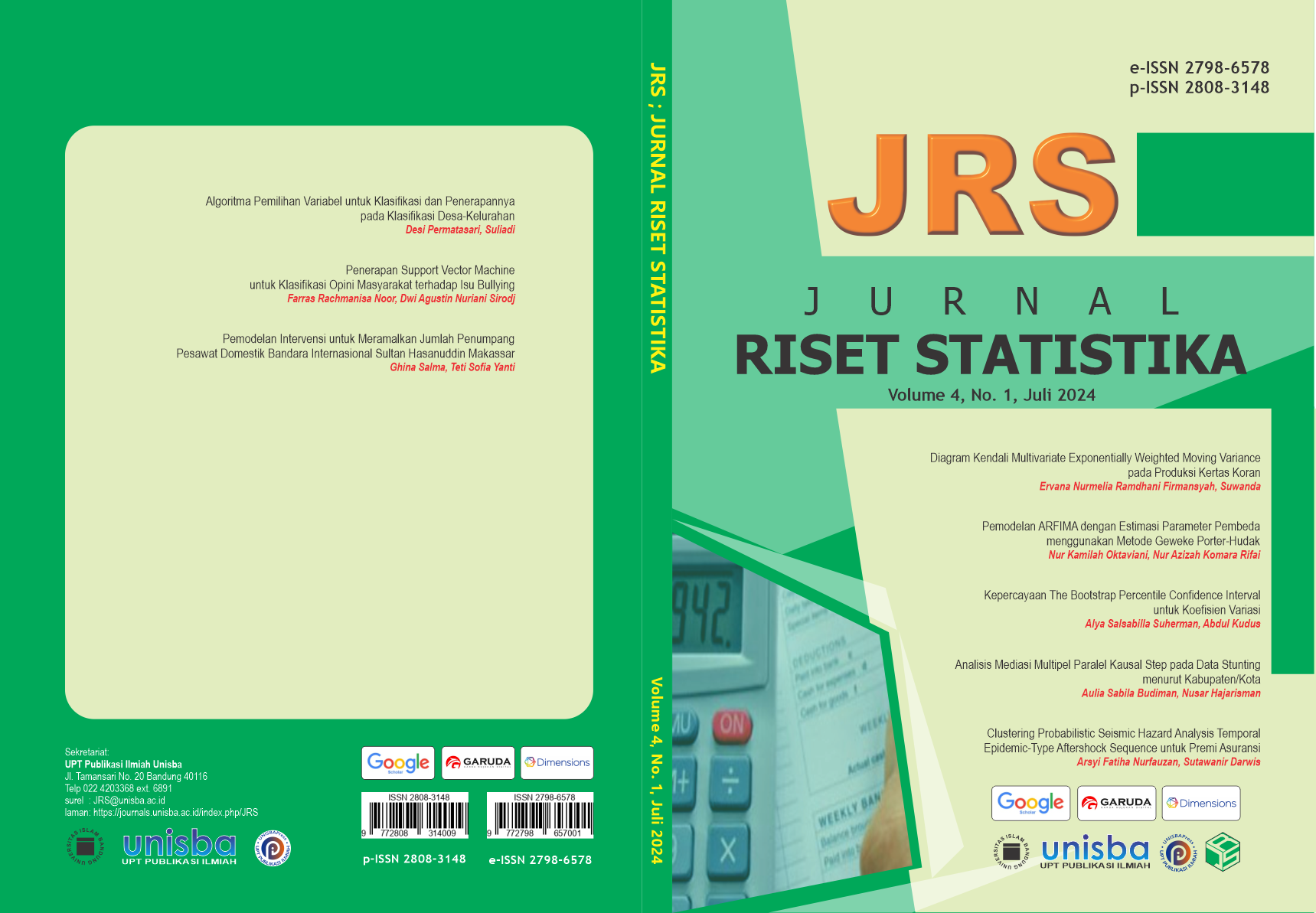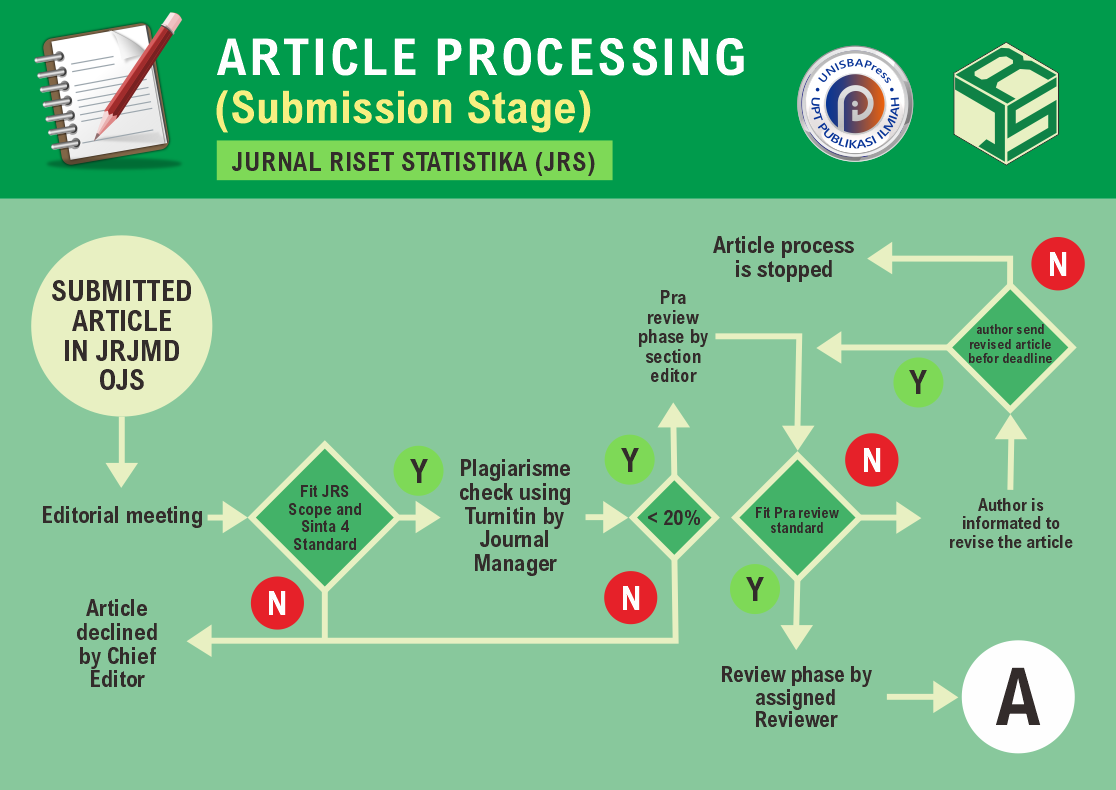Kepercayaan The Bootstrap Percentile Confidence Interval untuk Koefisien Variasi
DOI:
https://doi.org/10.29313/jrs.v4i1.3854Keywords:
Distribusi Invers Gaussian, Bootstrap Percentile Confidence Interval, Kualitas UdaraAbstract
Abstract. The Inverse Gaussian (IG) distribution is used to model data that has a positively skewed or right-skewed distribution. The coefficient of variation (CV) is the ratio of the standard deviation to the mean value. It reflects a good measure of dispersion used when comparing two or more groups of data. One method for estimating the coefficient of variation (CV) confidence interval is The Bootstrap Percentile Confidence Interval (BPCI) method. In this thesis, the BPCI method will be applied to the coefficient of variation of the IG distribution on PM 2.5 air quality data. In the research process, the stages of analysis carried out include calculating the estimated parameters of the IG distribution using the maximum likelihood method, conducting the Kolmogorov-Smirnov fit test, generating data with parameters as estimated and estimating the parameters 1000 times, then calculating the 95% confidence interval with the BPCI method. Based on the calculation results, it is obtained that the PM 2.5 air quality data in Semarang City in 2023 is suitable to be modeled with IG distribution and BPCI confidence interval with 95% confidence level for KV of the data is between the range [0.31 ;0.42].
Abstrak. Distribusi Invers Gaussian (IG) digunakan untuk memodelkan data yang memiliki distribusi kemiringan positif atau condong kekanan. Koefisien variasi (KV) merupakan perbandingan antara standar deviasi dengan nilai rata-rata. KV mencerminkan ukuran penyebaran yang baik digunakan ketika membandingkan dua atau lebih kelompok data. Salah satu metode untuk menaksir selang kepercayaan koefisien variasi (KV) yaitu metode The Bootstrap Percentile Confidence Interval (BPCI). Dalam skripsi ini akan dilakukan penerapan metode BPCI untuk koefisien variasi dari distribusi IG pada data kualitas udara PM 2.5. Dalam proses penelitian tahapan analisis yang dilakukan meliputi menghitung taksiran parameter dari distribusi IG menggunakan metode maksimum likelihood, melakukan uji kecocokan Kolmogorov-Smirnov, membangkitkan data dengan parameter sebagaimana taksirannya dan menaksir parameternya sebanyak 1000 kali, kemudian menghitung selang kepercayaan 95% dengan metode BPCI. Berdasarkan hasil perhitungan diperoleh bahwa data kualitas udara PM 2.5 di Kota Semarang tahun 2023 cocok dimodelkan dengan distribusi IG dan selang kepercayaan BPCI dengan tingkat kepercayaan 95% untuk KV dari data tersebut berada diantara rentang [0,31 ;0,42].
References
C. J. Schwarz and M. Samanta, “An Inductive Proof of the Sampling Distributions for the MLE’s of the Parameters in an Inverse Gaussian Distribution,” Am Stat, vol. 45, no. 3, pp. 223–225, Aug. 1991, doi: 10.1080/00031305.1991.10475807.
G. S. Datta and S. K. Sarkar, “A General Proof of Some Known Results of Independence Between Two Statistics,” Am Stat, vol. 62, no. 2, pp. 141–143, May 2008, doi: 10.1198/000313008X303955.
J. L. Folks and R. S. Chhikara, The Inverse Gaussian Distribution. New York: Marcel Dekker, 1989.
Gavriil I, Grivas G, Kassomenos P, Chaloulakou A, and Spyrellis N, “An application of theoretical probability distributions, to the study of PM10 and PM2.5 time series in Athens, Greece,” Global NEST Journal, vol. 8, no. 3, pp. 241–251, Apr. 2013, doi: 10.30955/gnj.000401.
W. Chankham, S.-A. Niwitpong, and S. Niwitpong, “Measurement of Dispersion of PM 2.5 in Thailand using Confidence Intervals for The Coefficient of Variation of an Inverse Gaussian Distribution,” PeerJ, vol. 10, p. e12988, Feb. 2022, doi: 10.7717/peerj.12988.
M. C. K. Tweedie, “Statistical Properties of Inverse Gaussian Distributions,” The Annals of Mathematical Statistics, vol. 28, no. 2, pp. 362–377, Jun. 1957, doi: 10.1214/aoms/1177706964.
M. Bernardino, “Penerapan CUSUM-Tukey’s Control Chart untuk Mendeteksi Perubahan Rata-Rata Proses pada Data Non-Normal,” Jurnal Riset Statistika, vol. 3, no. 2, pp. 119–124, Dec. 2023, doi: 10.29313/jrs.v3i2.2955.
H. J. Putri and Y. Ramdani, “Prediksi Hujan Rencana Tahunan Di Stasiun Palolo, Sulawesi Tengah menggunakan Metode Gumbel, Log Normal, Dan Log Pearson III,” DataMath: Journal of Statistics and Mathematics, vol. 2, no. 1, pp. 17–24, 2024.
V. K. M. Putri and S. Gischa, “Kualitas Udara: Pengertian, Parameter, dan Cara Menjaganya,” Kompas.com. Accessed: Jul. 18, 2024. [Online]. Available: https://www.kompas.com/skola/read/2021/07/09/110000769/kualitas-udara--pengertian-parameter-dan-cara-menjaganya
D. Chaniago, A. Zahara, and I. S. Ramadhani, “Indeks Standar Pencemar Udara (ISPU) sebagai Informasi Mutu Udara Ambien di Indonesia,” Kementrian Lingkungan Hidup dan Kehutanan. Accessed: Jul. 18, 2024. [Online]. Available: https://ditppu.menlhk.go.id/portal/read/indeks-standar-pencemar-udara-ispu-sebagai-informasi-mutu-udara-ambien-di-indonesia.
A. K. Mutaqin, “Distribusi Invers Gaussian Sebagai Salah Satu Distribusi Kegagalan,” Statistika, vol. 1, no. 1, 2001.
A. K. Mutaqin, “Penurunan Fungsi Distribusi Kumulatif dari Distribusi Invers Gaussian,” Statistika, vol. 4, no. 1, 2004.
D. L. Fajri, “Mengenal PM 2.5 dan PM 10, Partikel Berbahaya bagi Tubuh,” Katadata.co.id.
S. Nugroho, Statistika Nonparametrika, 1st ed. Bengkulu: UNIB Press, 2008.
E. Damanik and E. Simamora, “Estimasi Interval Kepercayaan Parameter Selisih Rata-rata IPK Kelas Pendidikan Reguler dan Ekstensi FMIPA Angkatan 2010 Unimed dengan Bootstrap Pensentil,” Karismatika, vol. 5, no. 3, pp. 1–9, 2019.
C. Putri, K. A. Notodiputro, and L. O. A. Rahman, “Bootstrap Parametrik dan Nonparametrik untuk Pendugaan Kuadrat Tengah Galat dalam Statistik Area Kecil dengan Respon Bersebaran Lognormal,” Forum Statistika dan Komputasi : Indonesian Journal of Statistic, vol. 18, no. 1, pp. 28–35, 2013.
W. Chankham, S.-A. Niwitpong, and S. Niwitpong, “Confidence Intervals for Coefficient of Variation of Inverse Gaussian Distribution,” in Proceedings of the 3rd International Conference on Vision, Image and Signal Processing, New York, NY, USA: ACM, Aug. 2019, pp. 1–6. doi: 10.1145/3387168.3387254.
B. Efron and R. Tibshirani, “Bootstrap Methods for Standard Errors, Confidence Intervals, and Other Measures of Statistical Accuracy,” Statistical Science, vol. 1, no. 1, pp. 54–77, Feb. 1986, doi: 10.1214/ss/1177013815.













